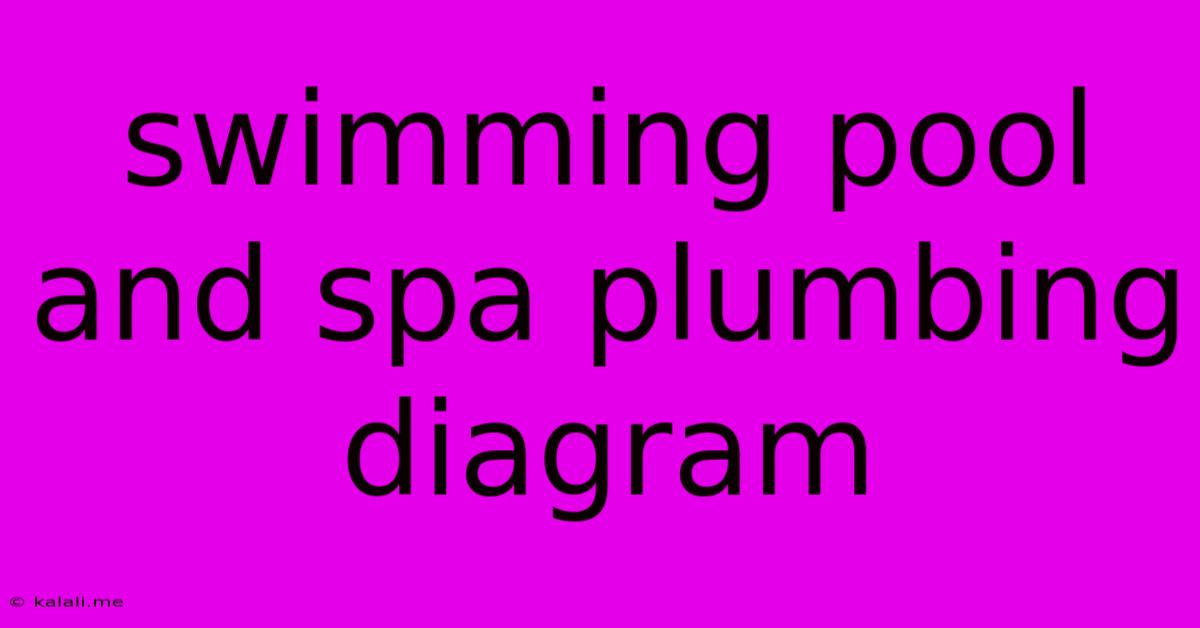Swimming Pool And Spa Plumbing Diagram
Kalali
Jun 02, 2025 · 4 min read

Table of Contents
Decoding the Depths: A Comprehensive Guide to Swimming Pool and Spa Plumbing Diagrams
Understanding your swimming pool and spa's plumbing system is crucial for maintenance, troubleshooting, and ensuring the longevity of your investment. This comprehensive guide will walk you through the essential components of a typical swimming pool and spa plumbing diagram, explaining their functions and interconnections. Whether you're a seasoned pool owner or a new enthusiast, this guide will equip you with the knowledge to navigate the intricacies of your aquatic system.
Understanding the Basics: Key Components and Their Roles
A typical swimming pool and spa plumbing system involves a network of pipes, valves, and equipment working in harmony to filter, heat, and circulate water. Let's break down the core components:
1. The Pump: The Heart of the System
The pump is the powerhouse, responsible for drawing water from the pool or spa and pushing it through the filtration system. Its power is measured in horsepower (HP), with higher HP indicating greater flow rate and capacity. Understanding your pump's specifications is essential for proper maintenance and efficient operation.
2. The Filter: Maintaining Pristine Water
The filter is the purification center, removing debris, contaminants, and other impurities from the water. Common filter types include sand, cartridge, and diatomaceous earth (DE) filters, each with its own pros and cons in terms of efficiency and maintenance. Regular backwashing or cleaning is vital to maintain optimal filtration.
3. The Heater: Achieving the Perfect Temperature
For year-round enjoyment, a heater maintains the desired water temperature. Gas and electric heaters are common choices, each offering different energy efficiency and cost considerations. Understanding your heater's BTU (British Thermal Units) rating helps determine its heating capacity.
4. The Valves: Controlling Water Flow
Various valves throughout the system regulate water flow, directing it to different components. These include multi-port valves (used for filtering and backwashing), isolation valves (allowing for individual component maintenance), and check valves (preventing backflow). Mastering the function of these valves is key to efficient system operation and troubleshooting.
5. The Plumbing Lines: The Arteries of the System
The network of pipes connecting all components forms the circulatory system. Proper sizing and material selection are critical for efficient water flow and longevity. PVC (polyvinyl chloride) is a common choice due to its durability and resistance to corrosion.
6. The Returns and Skimmers: Water Circulation
Returns are strategically placed jets that reintroduce filtered water back into the pool or spa, creating gentle circulation. Skimmers collect surface debris and draw it into the filtration system. Their placement and design significantly impact the overall water quality and cleanliness.
7. The Main Drain: Ensuring Safety and Cleanliness
The main drain is a crucial safety feature, preventing water from accumulating at the bottom of the pool and creating suction hazards. It also assists in the overall circulation of pool water, ensuring even cleaning and filtration.
Interpreting a Plumbing Diagram: A Visual Guide
Plumbing diagrams provide a visual representation of the system's layout, showing the interconnection of all components. They use symbols to represent each part, making it easier to understand the flow of water. Familiarizing yourself with these symbols is crucial for interpreting your pool's specific plumbing plan. Look for diagrams showing the path of water from the pump, through the filter, heater (if applicable), and back into the pool.
Troubleshooting and Maintenance: Utilizing Your Diagram
Your plumbing diagram becomes an invaluable tool when troubleshooting problems. By understanding the flow of water, you can quickly identify potential blockages, leaks, or malfunctioning components. Regularly checking your diagram alongside routine maintenance will help you prevent costly repairs and ensure the continued enjoyment of your pool or spa.
Beyond the Basics: Advanced Features and Considerations
More complex systems may include additional components such as automatic cleaners, water features, and specialized filtration systems. While the basic principles remain the same, understanding the role of these additional elements enhances the overall functionality and performance of your pool and spa. Consult with a qualified pool professional for guidance on more advanced plumbing configurations.
By understanding the components and flow of a swimming pool and spa plumbing diagram, you're better equipped to maintain your investment and enjoy years of trouble-free aquatic relaxation. Remember, prevention is key – regular inspections and proactive maintenance are always better than reactive repairs.
Latest Posts
Latest Posts
-
Can You Run An 800a Service Overhead From Transformer
Jun 04, 2025
-
Why Did Jesus Wash The Disciples Feet
Jun 04, 2025
-
What Does Te Quiero Mucho Mean
Jun 04, 2025
-
Top Speed Of Fa 18 Super Hornet
Jun 04, 2025
-
Linux Ss Command Show Port Number
Jun 04, 2025
Related Post
Thank you for visiting our website which covers about Swimming Pool And Spa Plumbing Diagram . We hope the information provided has been useful to you. Feel free to contact us if you have any questions or need further assistance. See you next time and don't miss to bookmark.